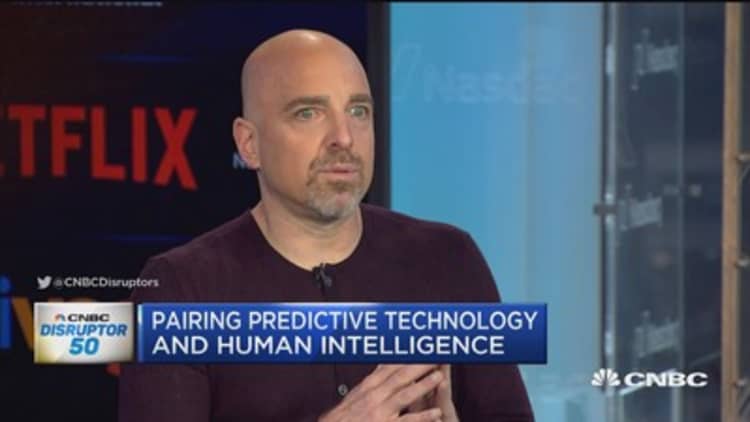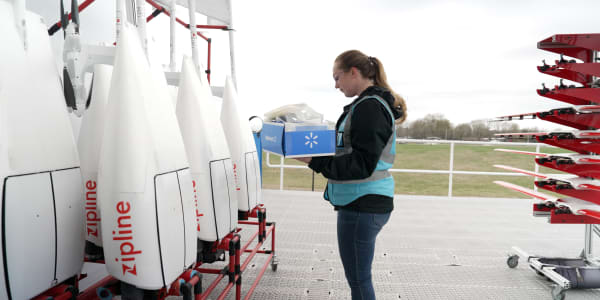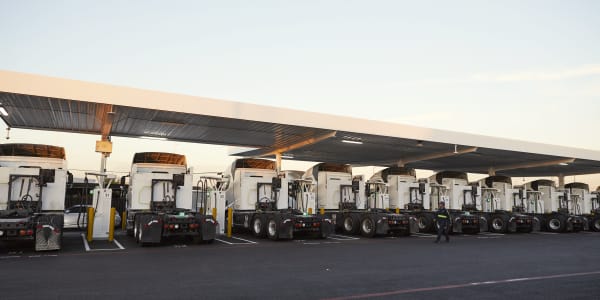
Brad Keywell is enjoying a repeat act. In the short period of time since he co-founded Chicago-based Uptake Technologies in July 2014, Keywell has seen his start-up reach a $2 billion valuation on the back of $146 million in funding, including $40 million from Revolution Growth, the venture firm of AOL co-founder Steve Case. It makes Uptake one of the fastest start-ups to ever reach $2 billion in value, along with Groupon, the daily deals company also based in Chicago, which Keywell co-founded in 2008.
But Uptake is nothing like Keywell's previous performance. Keywell's new start-up is in the business of predictive analytics, creating platform software that crunches data compiled by companies in a variety of industries — construction,
"The goal of insight platforms in industry is to increase uptime and increase safety. You're trying to increase productivity and reliability," CEO Keywell said. "So you subscribe to the Uptake platform, and what you get ... presents to you analytic insights specific to the issues in your industry."
More from CNBC Disruptor 50:
Why Airbnb tops the 2017 Disruptor 50
How Lyft is outmaneuvering Uber in the heated ridesharing race
Snap out of it! This is 'the best of all IPO markets'
Caterpillar uses the platform — the construction equipment manufacturer was Uptake's launch partner — to detect when machinery is on the verge of breaking down. Now Warren Buffett's Berkshire Hathaway Energy — a portfolio worth $85 billion that includes renewable-energy companies — is getting in on the action. In March, Berkshire Hathaway Energy announced that two of its subsidiary companies (though not parent-company BHE itself) would use the Uptake platform to track their wind turbines, keeping tabs on when turbines are malfunctioning or in need of maintenance in an effort to increase efficiencies and reduce costs.
For BHE's subsidiaries, it's a savvy move. Wind turbines today are outfitted with hundreds of sensors, each one tracking different pieces of data: wind speed, oil pressure, torque, vibrations in the wind blades and more. In the aggregate, it's a mesmerizing, intimidating set of information to parse. Uptake's analytics platform does this automatically and in real time, sensing potential problems before they become real ones. On Uptake's 730-person staff, about 70 data scientists and 80 technologists are the minds behind this analytics platform.
"Wind turbines have all been fitted with numerous sensors so you can get more visibility into what's going on in your wind farm operations," said Stuart Ravens, an energy research analyst with the worldwide consulting firm Navigant. "You can become a far more profitable business just by using predictive analytics."
The next wave of competition
Predictive analytics is just the next iteration of the Internet of Things (IoT), the networked amalgamation of machinery, tools and appliances that work smarter and detect problems more quickly, thanks to the reams of data they collect for processing and analysis. Whereas big data was a mere buzzword only a few short years ago, advances and price reductions in sensor quality, cloud computing and data science allow start-ups like Uptake to come in and parse data for big companies, in turn enabling those companies to make their workplaces safer and cut expenses.
"Many enterprises have been capturing information for years, but they don't necessarily have the expertise and the skills internally to bring together this real-time, connected information," said Michele Pelino, an IoT analysts with Forrester.
It's a lucrative, growing field. By 2020 the market for predictive analytics is expected to reach $3.6 billion.
But Uptake is competing in a crowded market with a number of big players, some of which have their own big deals with the energy industry. Pelino said that one direct competitor to Uptake is C3 IoT, a company that's been developing enterprise analytics software since 2009 and counts Con Edison and Pella as customers. General Electric signed a deal with Exelon last fall for the energy utility to use its analytics software in 48 states. What's more, because GE has its own predictive analytics division, it enables the company to not only sell products but also subsequent services. So GE's aviation division, for example, not only sells jet engines, it also sells maintenance on that engine, and based on tracking data that GE collects and analyzes, it knows when to contact customers regarding maintenance.
"Instead of selling you just an airplane engine, you're being sold uptime for an engine," Pelino said. "They're not even selling a product anymore; they're selling a service that the product is enabling."
Uptake's not in that game, although Keywell claims the start-up is driving disruption of predictive analytics in other ways. Because Uptake's platform works across industries, knowledge gained in one industry can be applied to others. Tire pressure, and when it's running low, is an insight useful to both the construction and aerospace industries, for instance. In addition, Keywell argues that because Uptake is still a start-up, it has the flexibility to tailor its analytics platform for specific customers without wrangling legacy code or applications: It's building platforms with customers, as opposed to for customers.
A social mission
And Uptake's platform's capabilities aren't just limited to industry. Through the start-up's civic innovation arm, Beyond. Uptake, the analytics platform it has created will soon be used by non-profit organizations in Nepal focused on identifying people lost to human trafficking. The illegal underworld of trafficking generates roughly $150 billion in profits each year, principally from the roughly 4.5 million people trafficked for sexual exploitation, according to the International Labor Organization.
"One challenge the human trafficking field has had for the past 15 to 20 years is a real lack of information on where or how trafficking happens. As a result, it's hard to structure policies and prevention to disrupt trafficking networks," said Jennifer Penrose, director of data analysis for Polaris, the Washington, D.C., nonprofit that uses data to try to interrupt human trafficking practices.
Data analytics allows organizations the ability to recognize trafficking patterns. By getting a better sense of where trafficking is prevalent and who's doing the trafficking, anti-trafficking groups can develop strategies to shut down larger networks — the hubs of human trafficking — as opposed to smaller businesses like massage parlors where some trafficking victims end up.
The initial step, of course, is gathering the data and analyzing it in a discernible way. That's where Uptake will make its contribution in Nepal. A business intelligence application for non-profits trying to disrupt human trafficking in Nepal is going live later this month, according to an Uptake spokesperson.
Whether it's for a social mission or in the field of business, Keywell said Uptake's predictive analytics platform uses machine learning to give it a unique advantage. After a company has started using the Uptake platform, the platform refines the insights it delivers over time as it compares its recommendations offered against what actions technicians in the field performed.
The platform, in other words, is self-correcting, and capable of delivering better recommendations to technicians in the six industries Uptake now serves: construction, retail, aerospace, mining, rail, and energy, where new customer BHE is hoping to reap the rewards of predictive analytics.
Keywell, naturally, thinks that will happen. One recent example he cited took place earlier this month at a wind farm in northwest Iowa that has been using Uptake's platform. A problem was uncovered in one turbine's main bearing; the platform detected the problem and offered as an insight a recommendation to shut down the turbine. A technician, after verifying, in-person, the problem with the bearing, followed through. In Keywell's telling, shutting down the turbine and fixing the bearing was a cost of a few thousand dollars, as opposed to the quarter-million dollars that would have been lost in downtime, missed revenue, and repairs were the turbine allowed to keep operating with a defective bearing.
"People talk about the fourth Industrial Revolution — that's not a joke," Keywell said. "If you can give people super-human skills through predictive insights delivered through technology, companies can be safer and better."
— By Andrew Zaleski, special to CNBC.com









